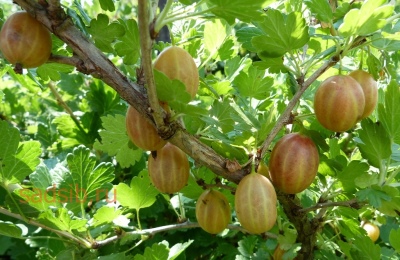
- Authors: V. S. Ilyin (South Ural Research Institute of Fruit and Vegetable Growing and Potato Growing)
- Appeared when crossing: Muromets x Lion
- Year of approval: 2004
- Growth type: vigorous
- Description of the bush: medium to low spread, dense
- Escapes: medium thickness, straight, green, with a noticeable anthocyanin coloration (light, dim) on the sunny side of the shoot, more often the upper thirds are colored
- Thorniness: weak
- Thorns: long, medium in thickness or thin, brown, one-, rarely two-part
- Sheet: medium-sized, dark green, glossy, wrinkled, five-lobed, deeply cut, concave, soft
- Spike location: located perpendicular to the shoot, less often - slightly upward; shoot often in the lower and upper parts without thorns; there is no spine of internodes
Most summer residents, planting a gooseberry bush, dream of a bountiful harvest of sweet berries. The varieties that give incredibly tasty berries include the mid-late Ural pink gooseberry of domestic selection.
Breeding history
The Ural pink gooseberry appeared thanks to the efforts of the scientist V.S.Ilyin of the South Ural Research Institute in 2002. The variety was obtained by crossing the varieties Lion and Muromets. The berry was added to the register of breeding achievements of the Russian Federation in 2004. The variety is recommended for cultivation in the West Siberian region.
Description of the variety
The mid-season gooseberry variety is a vigorous plant, stretching up to 120 cm in length. The shrub is characterized by moderate spreading of branches, upright thickened shoots, not very dense foliage with green leaves with a glossy surface and weak thorniness. As a rule, single-type thorns are distributed along the entire length of the shoots. Flowering at the bush begins after May 20. At this time, the crown is covered with small white-pinkish flowers, emitting a light aroma.
The variety has a high self-fertility (more than 60%), therefore it does not need donor shrubs.
Characteristics of berries
Ural pink represents the medium-fruited category. The berry weighs between 3.7 and 6.4 grams. The shape of the fruit is correct - rounded-oval with a smooth surface covered with a matte bloom. Sometimes the berries take on an elliptical shape. When ripe, the gooseberry has a very beautiful color - deep pink with light veins. The peel of the berries is dense, without pubescence, not hard.
Berries have a universal purpose - they are consumed fresh, frozen for the winter, compotes are boiled, processed into jams and marmalades, and are also widely used in cooking. The culture is distinguished by good transportability of fruits and their sufficient keeping quality. Gooseberries harvested at the stage of technical ripeness are characterized by longer storage.
Taste qualities
The berries have excellent taste. Light pink pulp contains few seeds, but a lot of vitamins and minerals. It is fleshy, tender, with a lot of juice. The fruit has a very sweet taste, with a pleasant sourness in the aftertaste. The aroma of berries is medium, sweet and pleasant. The pulp contains 5% sugars.
Ripening and fruiting
Ural pink is a vivid representative of a late-ripening culture. The first harvest can be observed in 2-3 years of plant growth.The berries ripen slowly and not at the same time, so the harvest is harvested in several stages with an interval of 10-14 days. The first ripe berries appear in mid-July. The phase of active fruiting occurs at the end of July-August. In a favorable environment, the shrub can bear fruit for about 20 years.
Yield
The yield indicators of the variety are excellent, the main thing is to follow all the rules of care and cultivation. Under favorable conditions, 1 bush can produce from 5.4 to 9.6 kg of sweet gooseberries. When growing a crop for commercial purposes, you can harvest 18 tons per hectare. High-quality pruning of branches will help to increase the yield.
Landing
You can plant gooseberry bushes in open ground in both spring and autumn. In the autumn period, this should be carried out in October, so that the plant has time to adapt to new growing conditions before the onset of cold weather. If you plant a bush in spring, then you need to wait for the moment when the snow melts, the soil and air will warm up a little, but the buds will not swell yet. The distance between plantings should be at least 2 meters. For planting, it is recommended to take 1-2 year old seedlings.

Growing and care
Gooseberries are not very capricious in their care, but they are quite picky about the place of growth and soil. The site should not be chosen in the lowlands, since the plant loves light, sun, heat and does not tolerate stagnant moisture.
In addition, the site must be protected from drafts and gusty winds. Loamy, sandy loam or sandy fertile soil with neutral or low acidity is considered favorable for growth.
Comprehensive crop care includes irrigation, top dressing three times a year, soil loosening, sanitary pruning and crown formation, as well as protection from pests and various diseases. Good mulching with peat or compost is sufficient to provide winter protection.



Disease and pest resistance
This variety has good resistance to diseases - anthracnose, septoria, fungal diseases. In addition, gooseberries are rarely affected by American powdery mildew and are also resistant to sawfly infestations.

In order for the gooseberry to produce a good harvest, it is necessary to devote time to disease prevention.
Resistance to adverse climatic conditions
The gooseberry is quite stress-resistant, so it is not afraid of sudden temperature fluctuations, recurrent spring frosts, a short drought and even extreme heat. It is also worth noting the high frost resistance of the plant. Shrubs do not like excessive moisture and strong winds.




































































